International Tourism System Analysis: Kuala Lumpur Destination
VerifiedAdded on 2021/06/15
|16
|4089
|48
Report
AI Summary
This report provides a detailed analysis of the international tourism system in Kuala Lumpur, Malaysia. It begins with an overview of tourist visitation trends, supported by statistical data, and identifies key factors that make Kuala Lumpur an attractive destination, drawing on theories of traveler satisfaction and motivation. The report then examines issues related to tourism and destination development, including language barriers, infrastructure limitations, and overdevelopment, as well as the negative impacts such as economic leakage and environmental damage. Positive impacts such as increased revenue are also discussed. Furthermore, the report analyzes the positive and negative impacts of tourism activities on the host community, addressing issues such as overcrowding, cultural shifts, and environmental concerns. Finally, it proposes and discusses four policy implications aimed at achieving sustainable tourism outcomes for Kuala Lumpur, concluding with a summary of findings and a reference list.

Running head: INTERNATIONAL TOURISM SYSTEM
International Tourism System
Student's name:
Name of the university:
Author’s note:
International Tourism System
Student's name:
Name of the university:
Author’s note:
Paraphrase This Document
Need a fresh take? Get an instant paraphrase of this document with our AI Paraphraser
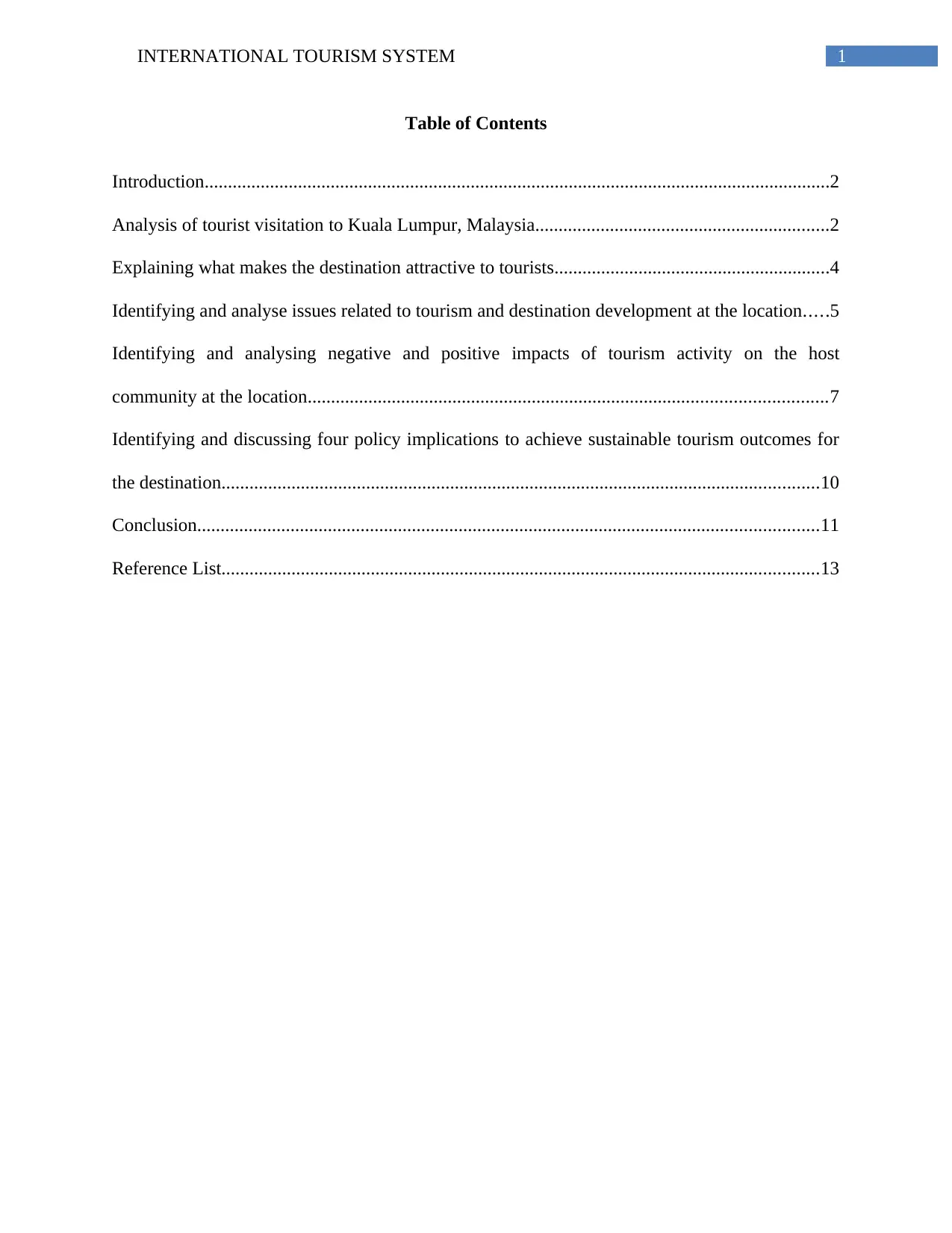
1INTERNATIONAL TOURISM SYSTEM
Table of Contents
Introduction......................................................................................................................................2
Analysis of tourist visitation to Kuala Lumpur, Malaysia...............................................................2
Explaining what makes the destination attractive to tourists...........................................................4
Identifying and analyse issues related to tourism and destination development at the location.....5
Identifying and analysing negative and positive impacts of tourism activity on the host
community at the location...............................................................................................................7
Identifying and discussing four policy implications to achieve sustainable tourism outcomes for
the destination................................................................................................................................10
Conclusion.....................................................................................................................................11
Reference List................................................................................................................................13
Table of Contents
Introduction......................................................................................................................................2
Analysis of tourist visitation to Kuala Lumpur, Malaysia...............................................................2
Explaining what makes the destination attractive to tourists...........................................................4
Identifying and analyse issues related to tourism and destination development at the location.....5
Identifying and analysing negative and positive impacts of tourism activity on the host
community at the location...............................................................................................................7
Identifying and discussing four policy implications to achieve sustainable tourism outcomes for
the destination................................................................................................................................10
Conclusion.....................................................................................................................................11
Reference List................................................................................................................................13

2INTERNATIONAL TOURISM SYSTEM
Introduction
International tourism has experienced rapid growth globally. In this study, Kuala Lumpur
is selected to show the international tourism system. Kuala Lumpur is the national capital of
Malaysia. Kuala Lumpur is among the fastest growing metropolitan regions in Asian countries.
In this study, tourist visitation in Kuala Lumpur is stated with support of the statistics.
Factors of tourism attraction of Kuala Lumpur are described providing the theoretical
background like travellers’ satisfaction and motivation to visit Kuala Lumpur. Issues of tourism
and destination development of Kuala Lumpur are explained. In addition, the negative and
positive impact of tourism activities on host community is described in this study.
Analysis of tourist visitation to Kuala Lumpur, Malaysia
Tourists’ visits in Kuala Lumpur are increasing and Kuala Lumpur is the second most-
visited South-Asian cities after Bangkok. According to Forbes Magazine, Kuala Lumpur is listed
ninth in the most visited city in the world, with 12.1 million international visitors in the year
2017. In the Malaysia, tourism board did aggressive promotion for tourism. The current target of
Kuala Lumpur is to drastically cut the budget for the tourism promotion; however, the main
target is to lure the regional, international and local travellers. In addition, in the year 2017,
Kuala Lumpur observed total 25.9 million travellers and the earned almost 82.1 billion receipts
(MYR) (Mus et al. 2017). This figure has been increasing over the last five years; however, this
figure slightly dropped in 2017. However, Kuala Lumpur gained 0.1% growth n tourist receipts
and the average length to stay (ALOS) for international tourists reduced to 5.7 nights from 5.9
nights in the last year.
Introduction
International tourism has experienced rapid growth globally. In this study, Kuala Lumpur
is selected to show the international tourism system. Kuala Lumpur is the national capital of
Malaysia. Kuala Lumpur is among the fastest growing metropolitan regions in Asian countries.
In this study, tourist visitation in Kuala Lumpur is stated with support of the statistics.
Factors of tourism attraction of Kuala Lumpur are described providing the theoretical
background like travellers’ satisfaction and motivation to visit Kuala Lumpur. Issues of tourism
and destination development of Kuala Lumpur are explained. In addition, the negative and
positive impact of tourism activities on host community is described in this study.
Analysis of tourist visitation to Kuala Lumpur, Malaysia
Tourists’ visits in Kuala Lumpur are increasing and Kuala Lumpur is the second most-
visited South-Asian cities after Bangkok. According to Forbes Magazine, Kuala Lumpur is listed
ninth in the most visited city in the world, with 12.1 million international visitors in the year
2017. In the Malaysia, tourism board did aggressive promotion for tourism. The current target of
Kuala Lumpur is to drastically cut the budget for the tourism promotion; however, the main
target is to lure the regional, international and local travellers. In addition, in the year 2017,
Kuala Lumpur observed total 25.9 million travellers and the earned almost 82.1 billion receipts
(MYR) (Mus et al. 2017). This figure has been increasing over the last five years; however, this
figure slightly dropped in 2017. However, Kuala Lumpur gained 0.1% growth n tourist receipts
and the average length to stay (ALOS) for international tourists reduced to 5.7 nights from 5.9
nights in the last year.
⊘ This is a preview!⊘
Do you want full access?
Subscribe today to unlock all pages.

Trusted by 1+ million students worldwide
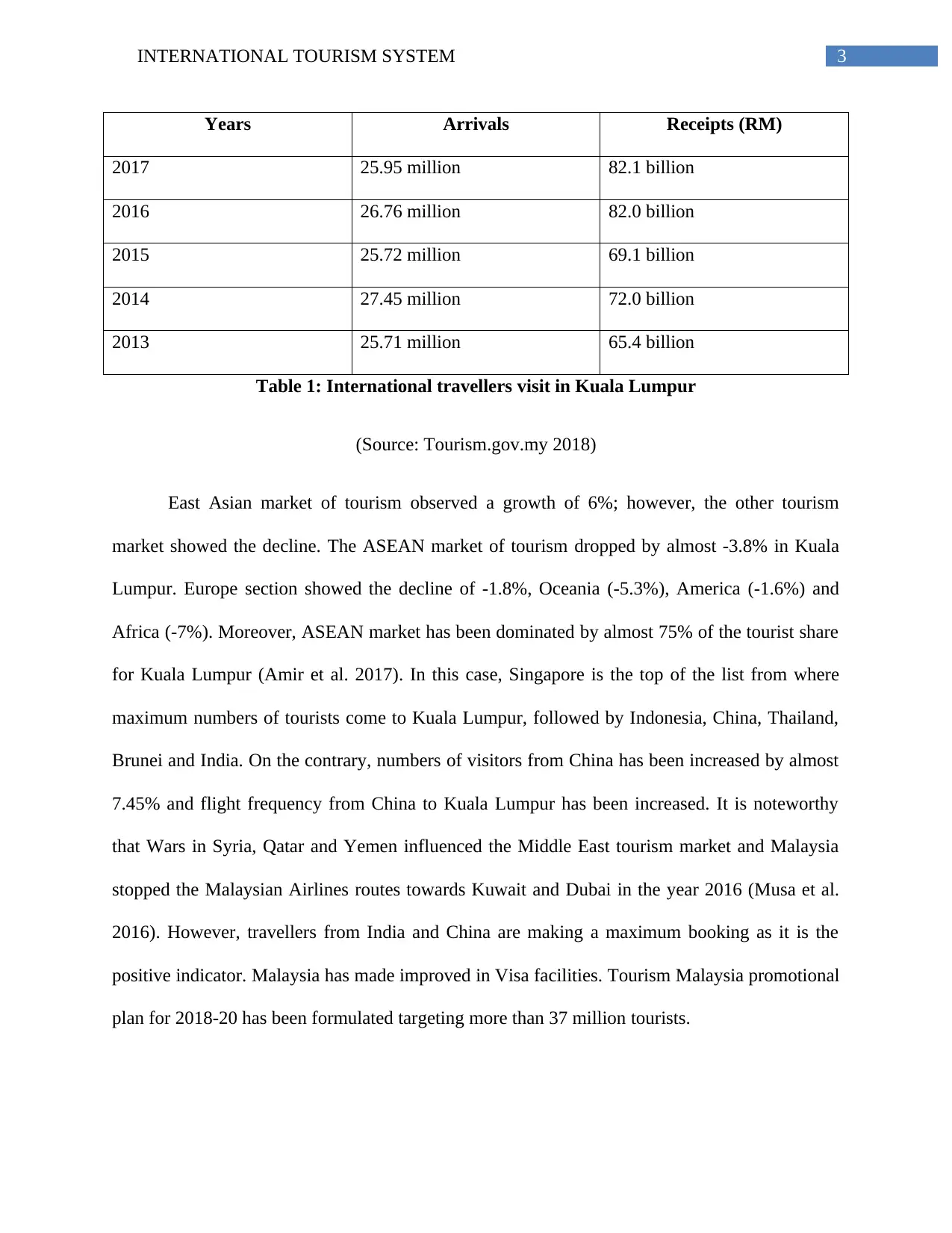
3INTERNATIONAL TOURISM SYSTEM
Years Arrivals Receipts (RM)
2017 25.95 million 82.1 billion
2016 26.76 million 82.0 billion
2015 25.72 million 69.1 billion
2014 27.45 million 72.0 billion
2013 25.71 million 65.4 billion
Table 1: International travellers visit in Kuala Lumpur
(Source: Tourism.gov.my 2018)
East Asian market of tourism observed a growth of 6%; however, the other tourism
market showed the decline. The ASEAN market of tourism dropped by almost -3.8% in Kuala
Lumpur. Europe section showed the decline of -1.8%, Oceania (-5.3%), America (-1.6%) and
Africa (-7%). Moreover, ASEAN market has been dominated by almost 75% of the tourist share
for Kuala Lumpur (Amir et al. 2017). In this case, Singapore is the top of the list from where
maximum numbers of tourists come to Kuala Lumpur, followed by Indonesia, China, Thailand,
Brunei and India. On the contrary, numbers of visitors from China has been increased by almost
7.45% and flight frequency from China to Kuala Lumpur has been increased. It is noteworthy
that Wars in Syria, Qatar and Yemen influenced the Middle East tourism market and Malaysia
stopped the Malaysian Airlines routes towards Kuwait and Dubai in the year 2016 (Musa et al.
2016). However, travellers from India and China are making a maximum booking as it is the
positive indicator. Malaysia has made improved in Visa facilities. Tourism Malaysia promotional
plan for 2018-20 has been formulated targeting more than 37 million tourists.
Years Arrivals Receipts (RM)
2017 25.95 million 82.1 billion
2016 26.76 million 82.0 billion
2015 25.72 million 69.1 billion
2014 27.45 million 72.0 billion
2013 25.71 million 65.4 billion
Table 1: International travellers visit in Kuala Lumpur
(Source: Tourism.gov.my 2018)
East Asian market of tourism observed a growth of 6%; however, the other tourism
market showed the decline. The ASEAN market of tourism dropped by almost -3.8% in Kuala
Lumpur. Europe section showed the decline of -1.8%, Oceania (-5.3%), America (-1.6%) and
Africa (-7%). Moreover, ASEAN market has been dominated by almost 75% of the tourist share
for Kuala Lumpur (Amir et al. 2017). In this case, Singapore is the top of the list from where
maximum numbers of tourists come to Kuala Lumpur, followed by Indonesia, China, Thailand,
Brunei and India. On the contrary, numbers of visitors from China has been increased by almost
7.45% and flight frequency from China to Kuala Lumpur has been increased. It is noteworthy
that Wars in Syria, Qatar and Yemen influenced the Middle East tourism market and Malaysia
stopped the Malaysian Airlines routes towards Kuwait and Dubai in the year 2016 (Musa et al.
2016). However, travellers from India and China are making a maximum booking as it is the
positive indicator. Malaysia has made improved in Visa facilities. Tourism Malaysia promotional
plan for 2018-20 has been formulated targeting more than 37 million tourists.
Paraphrase This Document
Need a fresh take? Get an instant paraphrase of this document with our AI Paraphraser
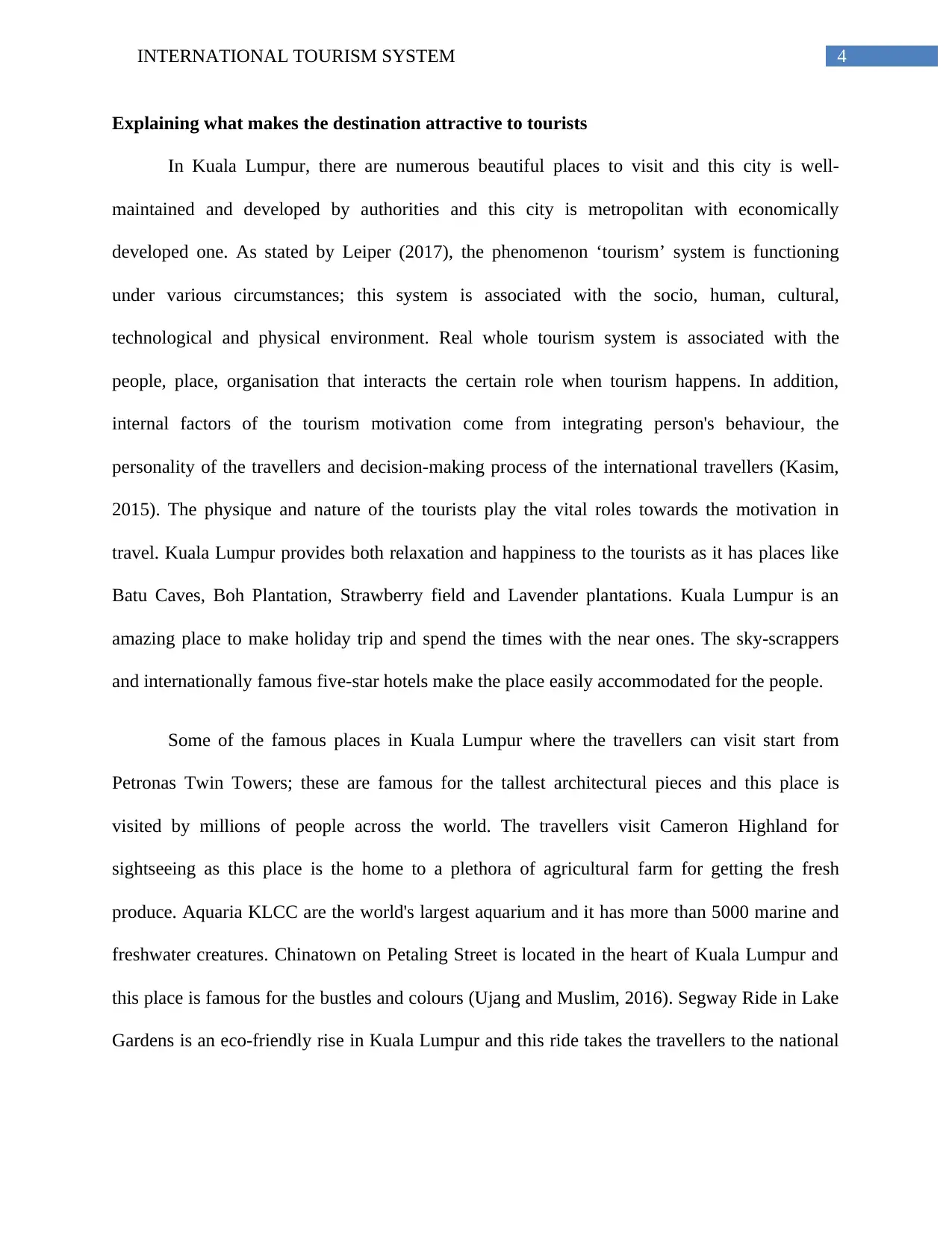
4INTERNATIONAL TOURISM SYSTEM
Explaining what makes the destination attractive to tourists
In Kuala Lumpur, there are numerous beautiful places to visit and this city is well-
maintained and developed by authorities and this city is metropolitan with economically
developed one. As stated by Leiper (2017), the phenomenon ‘tourism’ system is functioning
under various circumstances; this system is associated with the socio, human, cultural,
technological and physical environment. Real whole tourism system is associated with the
people, place, organisation that interacts the certain role when tourism happens. In addition,
internal factors of the tourism motivation come from integrating person's behaviour, the
personality of the travellers and decision-making process of the international travellers (Kasim,
2015). The physique and nature of the tourists play the vital roles towards the motivation in
travel. Kuala Lumpur provides both relaxation and happiness to the tourists as it has places like
Batu Caves, Boh Plantation, Strawberry field and Lavender plantations. Kuala Lumpur is an
amazing place to make holiday trip and spend the times with the near ones. The sky-scrappers
and internationally famous five-star hotels make the place easily accommodated for the people.
Some of the famous places in Kuala Lumpur where the travellers can visit start from
Petronas Twin Towers; these are famous for the tallest architectural pieces and this place is
visited by millions of people across the world. The travellers visit Cameron Highland for
sightseeing as this place is the home to a plethora of agricultural farm for getting the fresh
produce. Aquaria KLCC are the world's largest aquarium and it has more than 5000 marine and
freshwater creatures. Chinatown on Petaling Street is located in the heart of Kuala Lumpur and
this place is famous for the bustles and colours (Ujang and Muslim, 2016). Segway Ride in Lake
Gardens is an eco-friendly rise in Kuala Lumpur and this ride takes the travellers to the national
Explaining what makes the destination attractive to tourists
In Kuala Lumpur, there are numerous beautiful places to visit and this city is well-
maintained and developed by authorities and this city is metropolitan with economically
developed one. As stated by Leiper (2017), the phenomenon ‘tourism’ system is functioning
under various circumstances; this system is associated with the socio, human, cultural,
technological and physical environment. Real whole tourism system is associated with the
people, place, organisation that interacts the certain role when tourism happens. In addition,
internal factors of the tourism motivation come from integrating person's behaviour, the
personality of the travellers and decision-making process of the international travellers (Kasim,
2015). The physique and nature of the tourists play the vital roles towards the motivation in
travel. Kuala Lumpur provides both relaxation and happiness to the tourists as it has places like
Batu Caves, Boh Plantation, Strawberry field and Lavender plantations. Kuala Lumpur is an
amazing place to make holiday trip and spend the times with the near ones. The sky-scrappers
and internationally famous five-star hotels make the place easily accommodated for the people.
Some of the famous places in Kuala Lumpur where the travellers can visit start from
Petronas Twin Towers; these are famous for the tallest architectural pieces and this place is
visited by millions of people across the world. The travellers visit Cameron Highland for
sightseeing as this place is the home to a plethora of agricultural farm for getting the fresh
produce. Aquaria KLCC are the world's largest aquarium and it has more than 5000 marine and
freshwater creatures. Chinatown on Petaling Street is located in the heart of Kuala Lumpur and
this place is famous for the bustles and colours (Ujang and Muslim, 2016). Segway Ride in Lake
Gardens is an eco-friendly rise in Kuala Lumpur and this ride takes the travellers to the national
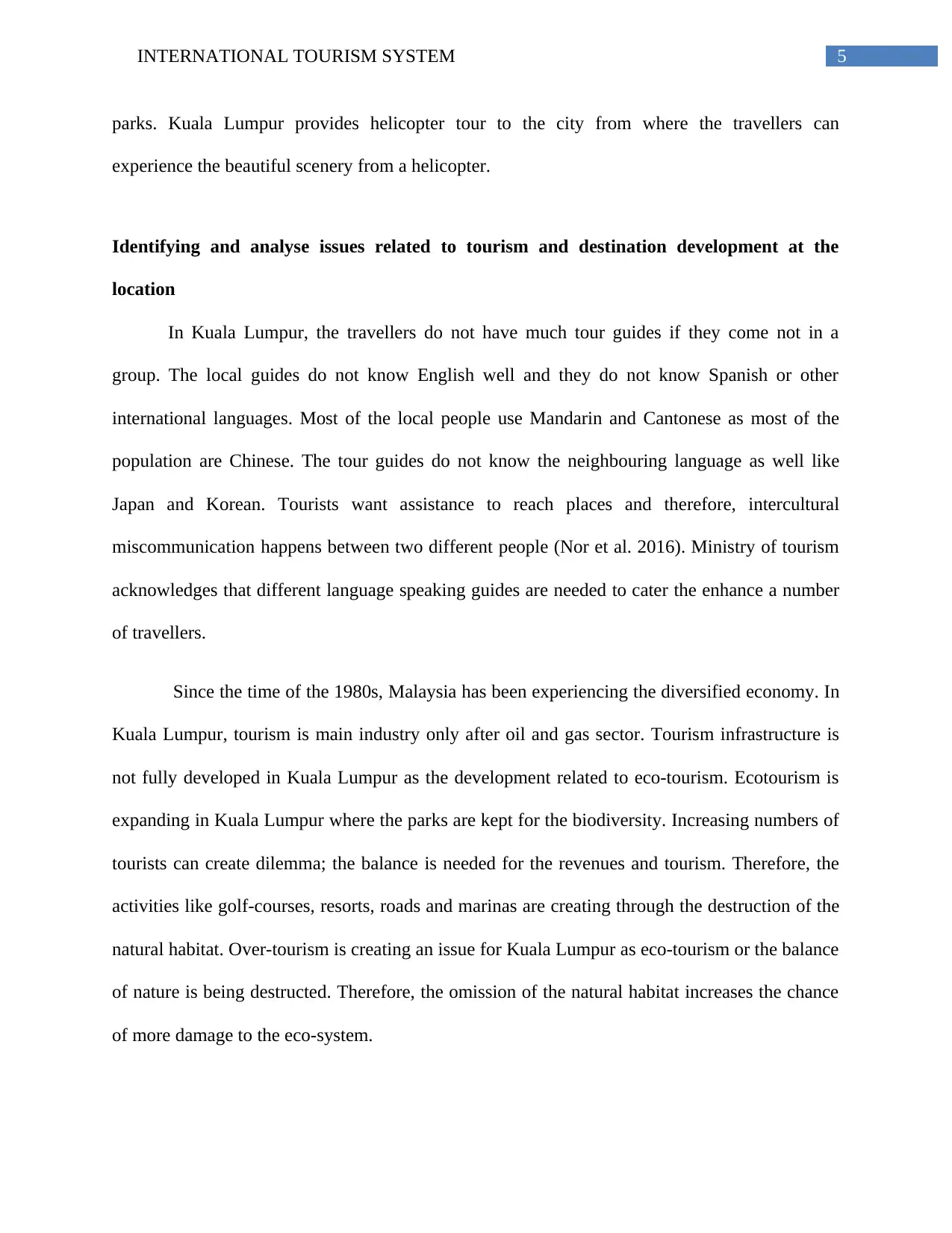
5INTERNATIONAL TOURISM SYSTEM
parks. Kuala Lumpur provides helicopter tour to the city from where the travellers can
experience the beautiful scenery from a helicopter.
Identifying and analyse issues related to tourism and destination development at the
location
In Kuala Lumpur, the travellers do not have much tour guides if they come not in a
group. The local guides do not know English well and they do not know Spanish or other
international languages. Most of the local people use Mandarin and Cantonese as most of the
population are Chinese. The tour guides do not know the neighbouring language as well like
Japan and Korean. Tourists want assistance to reach places and therefore, intercultural
miscommunication happens between two different people (Nor et al. 2016). Ministry of tourism
acknowledges that different language speaking guides are needed to cater the enhance a number
of travellers.
Since the time of the 1980s, Malaysia has been experiencing the diversified economy. In
Kuala Lumpur, tourism is main industry only after oil and gas sector. Tourism infrastructure is
not fully developed in Kuala Lumpur as the development related to eco-tourism. Ecotourism is
expanding in Kuala Lumpur where the parks are kept for the biodiversity. Increasing numbers of
tourists can create dilemma; the balance is needed for the revenues and tourism. Therefore, the
activities like golf-courses, resorts, roads and marinas are creating through the destruction of the
natural habitat. Over-tourism is creating an issue for Kuala Lumpur as eco-tourism or the balance
of nature is being destructed. Therefore, the omission of the natural habitat increases the chance
of more damage to the eco-system.
parks. Kuala Lumpur provides helicopter tour to the city from where the travellers can
experience the beautiful scenery from a helicopter.
Identifying and analyse issues related to tourism and destination development at the
location
In Kuala Lumpur, the travellers do not have much tour guides if they come not in a
group. The local guides do not know English well and they do not know Spanish or other
international languages. Most of the local people use Mandarin and Cantonese as most of the
population are Chinese. The tour guides do not know the neighbouring language as well like
Japan and Korean. Tourists want assistance to reach places and therefore, intercultural
miscommunication happens between two different people (Nor et al. 2016). Ministry of tourism
acknowledges that different language speaking guides are needed to cater the enhance a number
of travellers.
Since the time of the 1980s, Malaysia has been experiencing the diversified economy. In
Kuala Lumpur, tourism is main industry only after oil and gas sector. Tourism infrastructure is
not fully developed in Kuala Lumpur as the development related to eco-tourism. Ecotourism is
expanding in Kuala Lumpur where the parks are kept for the biodiversity. Increasing numbers of
tourists can create dilemma; the balance is needed for the revenues and tourism. Therefore, the
activities like golf-courses, resorts, roads and marinas are creating through the destruction of the
natural habitat. Over-tourism is creating an issue for Kuala Lumpur as eco-tourism or the balance
of nature is being destructed. Therefore, the omission of the natural habitat increases the chance
of more damage to the eco-system.
⊘ This is a preview!⊘
Do you want full access?
Subscribe today to unlock all pages.

Trusted by 1+ million students worldwide
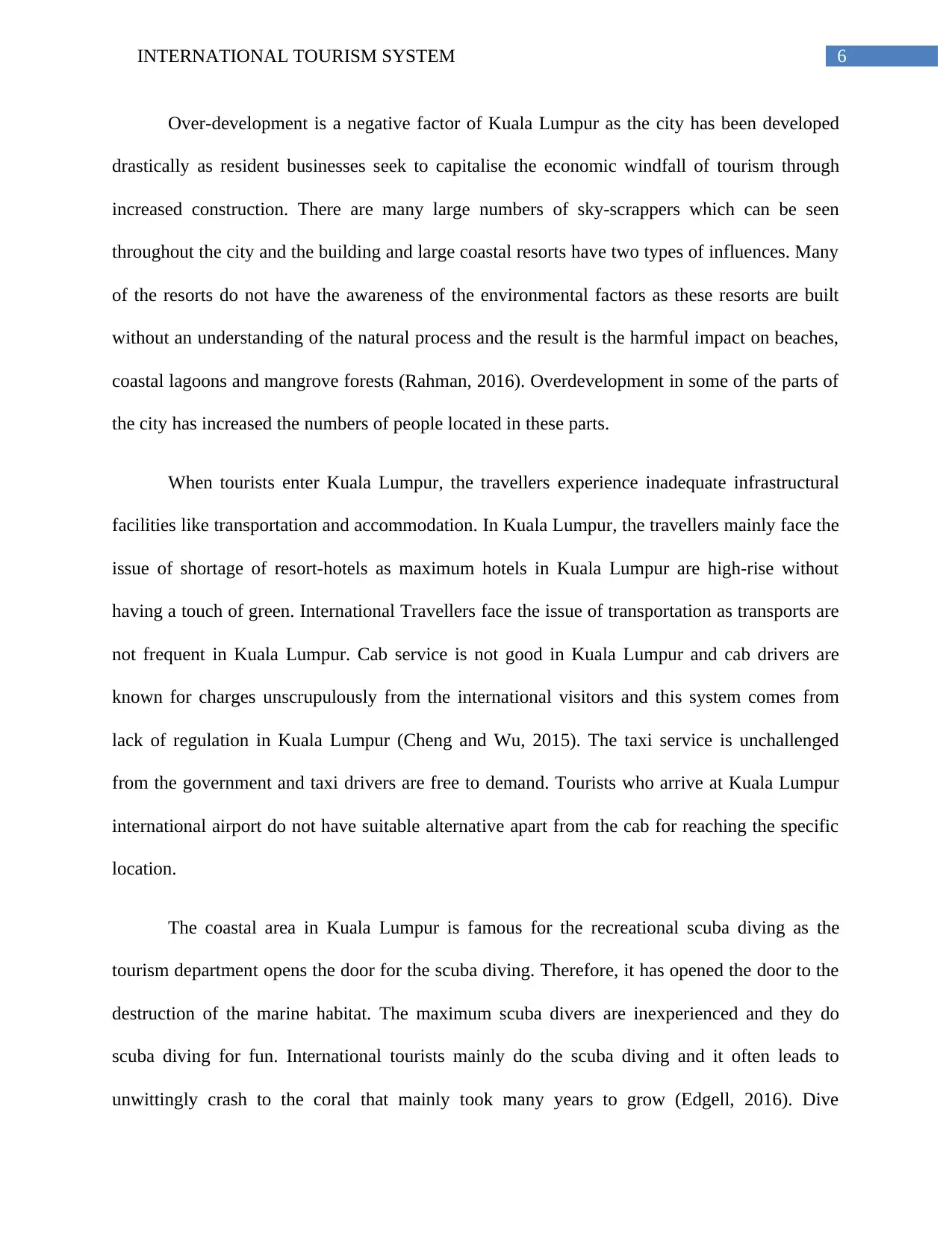
6INTERNATIONAL TOURISM SYSTEM
Over-development is a negative factor of Kuala Lumpur as the city has been developed
drastically as resident businesses seek to capitalise the economic windfall of tourism through
increased construction. There are many large numbers of sky-scrappers which can be seen
throughout the city and the building and large coastal resorts have two types of influences. Many
of the resorts do not have the awareness of the environmental factors as these resorts are built
without an understanding of the natural process and the result is the harmful impact on beaches,
coastal lagoons and mangrove forests (Rahman, 2016). Overdevelopment in some of the parts of
the city has increased the numbers of people located in these parts.
When tourists enter Kuala Lumpur, the travellers experience inadequate infrastructural
facilities like transportation and accommodation. In Kuala Lumpur, the travellers mainly face the
issue of shortage of resort-hotels as maximum hotels in Kuala Lumpur are high-rise without
having a touch of green. International Travellers face the issue of transportation as transports are
not frequent in Kuala Lumpur. Cab service is not good in Kuala Lumpur and cab drivers are
known for charges unscrupulously from the international visitors and this system comes from
lack of regulation in Kuala Lumpur (Cheng and Wu, 2015). The taxi service is unchallenged
from the government and taxi drivers are free to demand. Tourists who arrive at Kuala Lumpur
international airport do not have suitable alternative apart from the cab for reaching the specific
location.
The coastal area in Kuala Lumpur is famous for the recreational scuba diving as the
tourism department opens the door for the scuba diving. Therefore, it has opened the door to the
destruction of the marine habitat. The maximum scuba divers are inexperienced and they do
scuba diving for fun. International tourists mainly do the scuba diving and it often leads to
unwittingly crash to the coral that mainly took many years to grow (Edgell, 2016). Dive
Over-development is a negative factor of Kuala Lumpur as the city has been developed
drastically as resident businesses seek to capitalise the economic windfall of tourism through
increased construction. There are many large numbers of sky-scrappers which can be seen
throughout the city and the building and large coastal resorts have two types of influences. Many
of the resorts do not have the awareness of the environmental factors as these resorts are built
without an understanding of the natural process and the result is the harmful impact on beaches,
coastal lagoons and mangrove forests (Rahman, 2016). Overdevelopment in some of the parts of
the city has increased the numbers of people located in these parts.
When tourists enter Kuala Lumpur, the travellers experience inadequate infrastructural
facilities like transportation and accommodation. In Kuala Lumpur, the travellers mainly face the
issue of shortage of resort-hotels as maximum hotels in Kuala Lumpur are high-rise without
having a touch of green. International Travellers face the issue of transportation as transports are
not frequent in Kuala Lumpur. Cab service is not good in Kuala Lumpur and cab drivers are
known for charges unscrupulously from the international visitors and this system comes from
lack of regulation in Kuala Lumpur (Cheng and Wu, 2015). The taxi service is unchallenged
from the government and taxi drivers are free to demand. Tourists who arrive at Kuala Lumpur
international airport do not have suitable alternative apart from the cab for reaching the specific
location.
The coastal area in Kuala Lumpur is famous for the recreational scuba diving as the
tourism department opens the door for the scuba diving. Therefore, it has opened the door to the
destruction of the marine habitat. The maximum scuba divers are inexperienced and they do
scuba diving for fun. International tourists mainly do the scuba diving and it often leads to
unwittingly crash to the coral that mainly took many years to grow (Edgell, 2016). Dive
Paraphrase This Document
Need a fresh take? Get an instant paraphrase of this document with our AI Paraphraser
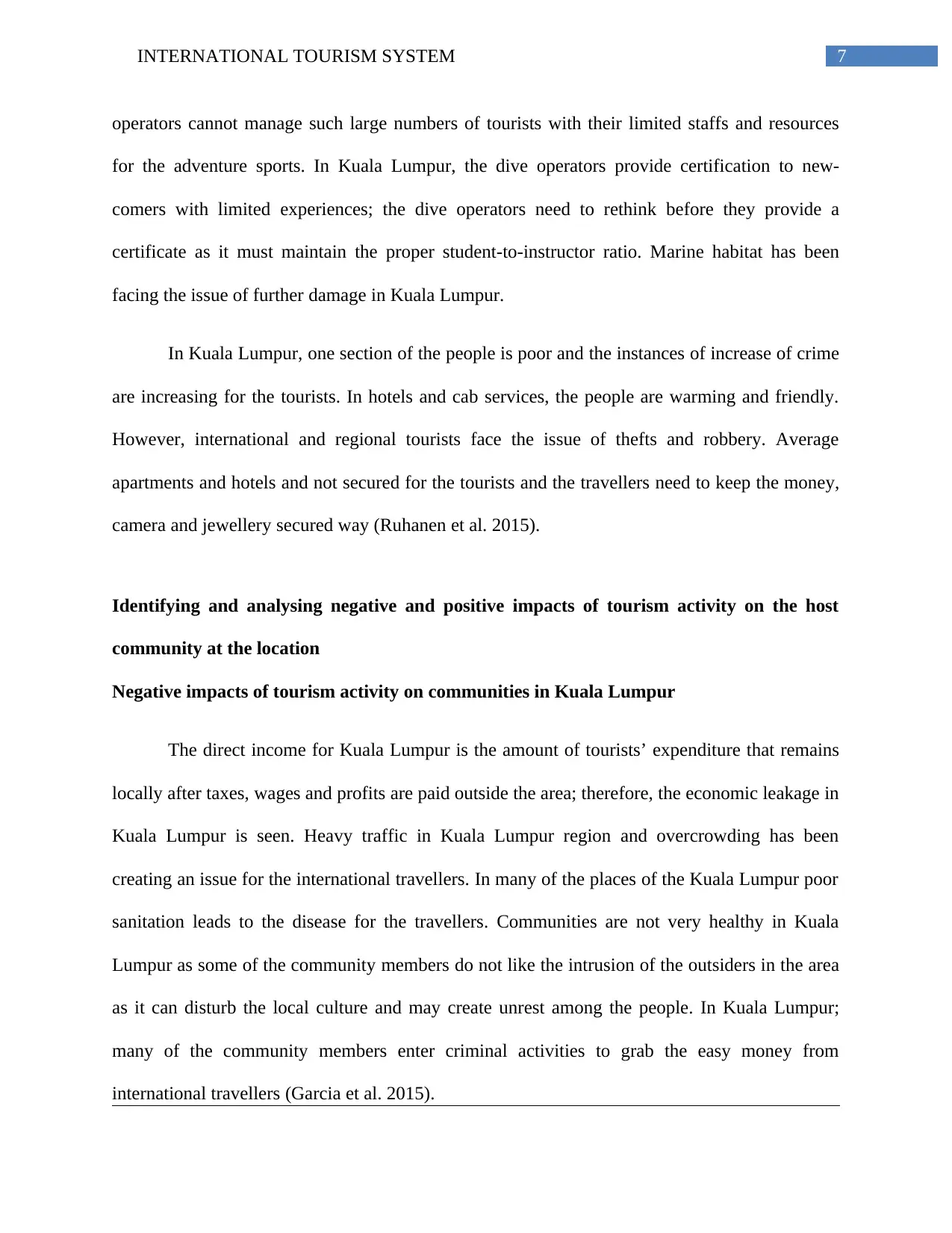
7INTERNATIONAL TOURISM SYSTEM
operators cannot manage such large numbers of tourists with their limited staffs and resources
for the adventure sports. In Kuala Lumpur, the dive operators provide certification to new-
comers with limited experiences; the dive operators need to rethink before they provide a
certificate as it must maintain the proper student-to-instructor ratio. Marine habitat has been
facing the issue of further damage in Kuala Lumpur.
In Kuala Lumpur, one section of the people is poor and the instances of increase of crime
are increasing for the tourists. In hotels and cab services, the people are warming and friendly.
However, international and regional tourists face the issue of thefts and robbery. Average
apartments and hotels and not secured for the tourists and the travellers need to keep the money,
camera and jewellery secured way (Ruhanen et al. 2015).
Identifying and analysing negative and positive impacts of tourism activity on the host
community at the location
Negative impacts of tourism activity on communities in Kuala Lumpur
The direct income for Kuala Lumpur is the amount of tourists’ expenditure that remains
locally after taxes, wages and profits are paid outside the area; therefore, the economic leakage in
Kuala Lumpur is seen. Heavy traffic in Kuala Lumpur region and overcrowding has been
creating an issue for the international travellers. In many of the places of the Kuala Lumpur poor
sanitation leads to the disease for the travellers. Communities are not very healthy in Kuala
Lumpur as some of the community members do not like the intrusion of the outsiders in the area
as it can disturb the local culture and may create unrest among the people. In Kuala Lumpur;
many of the community members enter criminal activities to grab the easy money from
international travellers (Garcia et al. 2015).
operators cannot manage such large numbers of tourists with their limited staffs and resources
for the adventure sports. In Kuala Lumpur, the dive operators provide certification to new-
comers with limited experiences; the dive operators need to rethink before they provide a
certificate as it must maintain the proper student-to-instructor ratio. Marine habitat has been
facing the issue of further damage in Kuala Lumpur.
In Kuala Lumpur, one section of the people is poor and the instances of increase of crime
are increasing for the tourists. In hotels and cab services, the people are warming and friendly.
However, international and regional tourists face the issue of thefts and robbery. Average
apartments and hotels and not secured for the tourists and the travellers need to keep the money,
camera and jewellery secured way (Ruhanen et al. 2015).
Identifying and analysing negative and positive impacts of tourism activity on the host
community at the location
Negative impacts of tourism activity on communities in Kuala Lumpur
The direct income for Kuala Lumpur is the amount of tourists’ expenditure that remains
locally after taxes, wages and profits are paid outside the area; therefore, the economic leakage in
Kuala Lumpur is seen. Heavy traffic in Kuala Lumpur region and overcrowding has been
creating an issue for the international travellers. In many of the places of the Kuala Lumpur poor
sanitation leads to the disease for the travellers. Communities are not very healthy in Kuala
Lumpur as some of the community members do not like the intrusion of the outsiders in the area
as it can disturb the local culture and may create unrest among the people. In Kuala Lumpur;
many of the community members enter criminal activities to grab the easy money from
international travellers (Garcia et al. 2015).
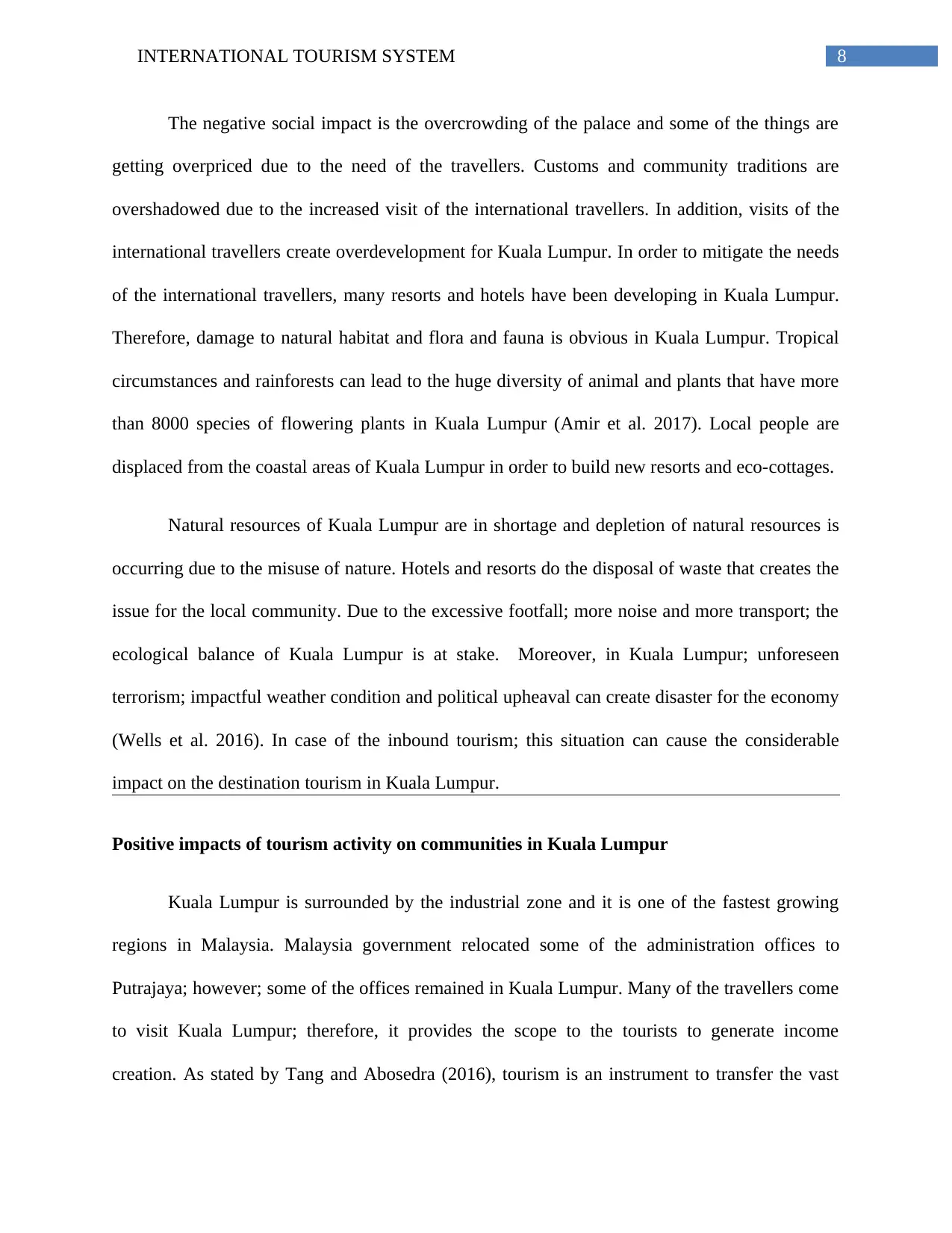
8INTERNATIONAL TOURISM SYSTEM
The negative social impact is the overcrowding of the palace and some of the things are
getting overpriced due to the need of the travellers. Customs and community traditions are
overshadowed due to the increased visit of the international travellers. In addition, visits of the
international travellers create overdevelopment for Kuala Lumpur. In order to mitigate the needs
of the international travellers, many resorts and hotels have been developing in Kuala Lumpur.
Therefore, damage to natural habitat and flora and fauna is obvious in Kuala Lumpur. Tropical
circumstances and rainforests can lead to the huge diversity of animal and plants that have more
than 8000 species of flowering plants in Kuala Lumpur (Amir et al. 2017). Local people are
displaced from the coastal areas of Kuala Lumpur in order to build new resorts and eco-cottages.
Natural resources of Kuala Lumpur are in shortage and depletion of natural resources is
occurring due to the misuse of nature. Hotels and resorts do the disposal of waste that creates the
issue for the local community. Due to the excessive footfall; more noise and more transport; the
ecological balance of Kuala Lumpur is at stake. Moreover, in Kuala Lumpur; unforeseen
terrorism; impactful weather condition and political upheaval can create disaster for the economy
(Wells et al. 2016). In case of the inbound tourism; this situation can cause the considerable
impact on the destination tourism in Kuala Lumpur.
Positive impacts of tourism activity on communities in Kuala Lumpur
Kuala Lumpur is surrounded by the industrial zone and it is one of the fastest growing
regions in Malaysia. Malaysia government relocated some of the administration offices to
Putrajaya; however; some of the offices remained in Kuala Lumpur. Many of the travellers come
to visit Kuala Lumpur; therefore, it provides the scope to the tourists to generate income
creation. As stated by Tang and Abosedra (2016), tourism is an instrument to transfer the vast
The negative social impact is the overcrowding of the palace and some of the things are
getting overpriced due to the need of the travellers. Customs and community traditions are
overshadowed due to the increased visit of the international travellers. In addition, visits of the
international travellers create overdevelopment for Kuala Lumpur. In order to mitigate the needs
of the international travellers, many resorts and hotels have been developing in Kuala Lumpur.
Therefore, damage to natural habitat and flora and fauna is obvious in Kuala Lumpur. Tropical
circumstances and rainforests can lead to the huge diversity of animal and plants that have more
than 8000 species of flowering plants in Kuala Lumpur (Amir et al. 2017). Local people are
displaced from the coastal areas of Kuala Lumpur in order to build new resorts and eco-cottages.
Natural resources of Kuala Lumpur are in shortage and depletion of natural resources is
occurring due to the misuse of nature. Hotels and resorts do the disposal of waste that creates the
issue for the local community. Due to the excessive footfall; more noise and more transport; the
ecological balance of Kuala Lumpur is at stake. Moreover, in Kuala Lumpur; unforeseen
terrorism; impactful weather condition and political upheaval can create disaster for the economy
(Wells et al. 2016). In case of the inbound tourism; this situation can cause the considerable
impact on the destination tourism in Kuala Lumpur.
Positive impacts of tourism activity on communities in Kuala Lumpur
Kuala Lumpur is surrounded by the industrial zone and it is one of the fastest growing
regions in Malaysia. Malaysia government relocated some of the administration offices to
Putrajaya; however; some of the offices remained in Kuala Lumpur. Many of the travellers come
to visit Kuala Lumpur; therefore, it provides the scope to the tourists to generate income
creation. As stated by Tang and Abosedra (2016), tourism is an instrument to transfer the vast
⊘ This is a preview!⊘
Do you want full access?
Subscribe today to unlock all pages.

Trusted by 1+ million students worldwide
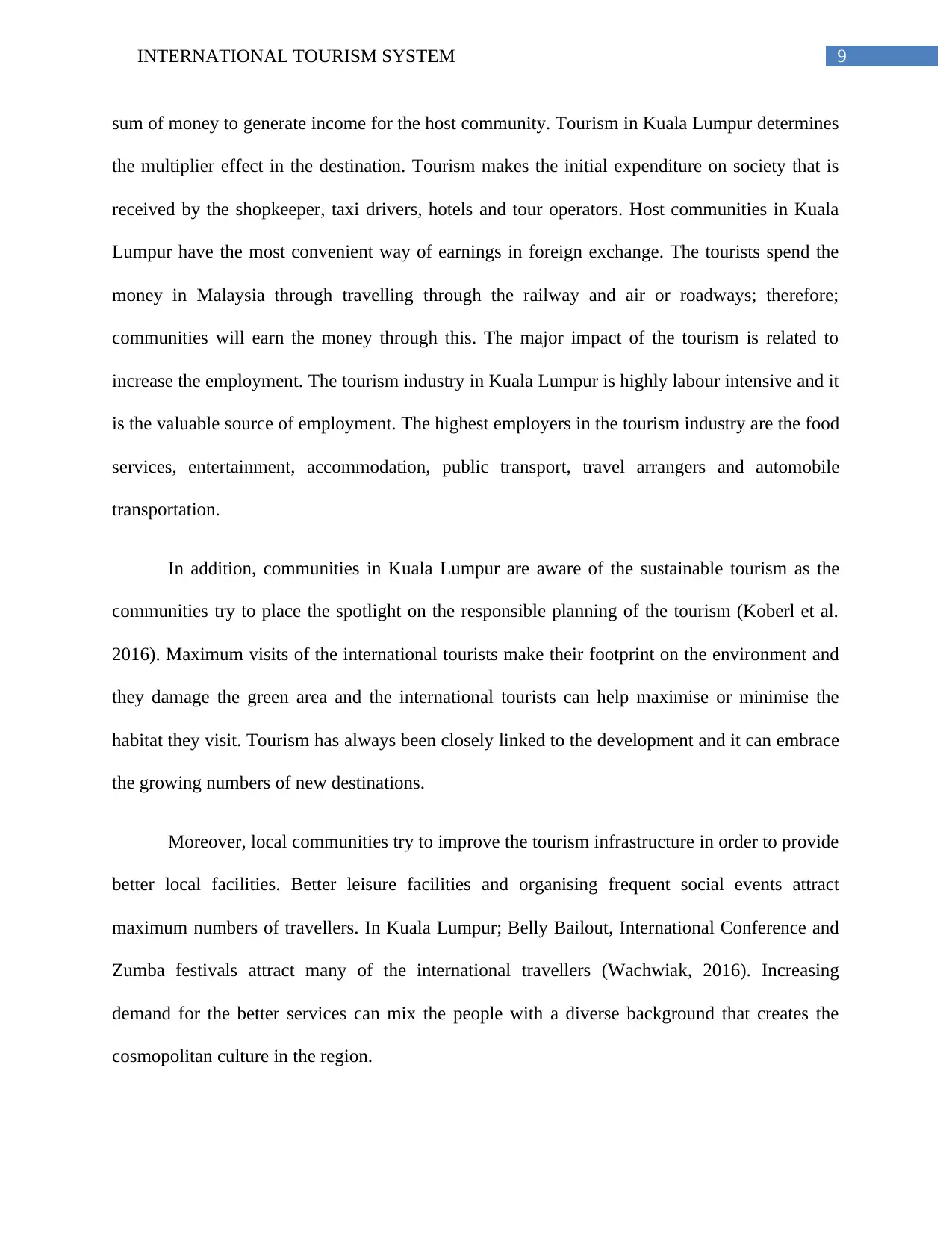
9INTERNATIONAL TOURISM SYSTEM
sum of money to generate income for the host community. Tourism in Kuala Lumpur determines
the multiplier effect in the destination. Tourism makes the initial expenditure on society that is
received by the shopkeeper, taxi drivers, hotels and tour operators. Host communities in Kuala
Lumpur have the most convenient way of earnings in foreign exchange. The tourists spend the
money in Malaysia through travelling through the railway and air or roadways; therefore;
communities will earn the money through this. The major impact of the tourism is related to
increase the employment. The tourism industry in Kuala Lumpur is highly labour intensive and it
is the valuable source of employment. The highest employers in the tourism industry are the food
services, entertainment, accommodation, public transport, travel arrangers and automobile
transportation.
In addition, communities in Kuala Lumpur are aware of the sustainable tourism as the
communities try to place the spotlight on the responsible planning of the tourism (Koberl et al.
2016). Maximum visits of the international tourists make their footprint on the environment and
they damage the green area and the international tourists can help maximise or minimise the
habitat they visit. Tourism has always been closely linked to the development and it can embrace
the growing numbers of new destinations.
Moreover, local communities try to improve the tourism infrastructure in order to provide
better local facilities. Better leisure facilities and organising frequent social events attract
maximum numbers of travellers. In Kuala Lumpur; Belly Bailout, International Conference and
Zumba festivals attract many of the international travellers (Wachwiak, 2016). Increasing
demand for the better services can mix the people with a diverse background that creates the
cosmopolitan culture in the region.
sum of money to generate income for the host community. Tourism in Kuala Lumpur determines
the multiplier effect in the destination. Tourism makes the initial expenditure on society that is
received by the shopkeeper, taxi drivers, hotels and tour operators. Host communities in Kuala
Lumpur have the most convenient way of earnings in foreign exchange. The tourists spend the
money in Malaysia through travelling through the railway and air or roadways; therefore;
communities will earn the money through this. The major impact of the tourism is related to
increase the employment. The tourism industry in Kuala Lumpur is highly labour intensive and it
is the valuable source of employment. The highest employers in the tourism industry are the food
services, entertainment, accommodation, public transport, travel arrangers and automobile
transportation.
In addition, communities in Kuala Lumpur are aware of the sustainable tourism as the
communities try to place the spotlight on the responsible planning of the tourism (Koberl et al.
2016). Maximum visits of the international tourists make their footprint on the environment and
they damage the green area and the international tourists can help maximise or minimise the
habitat they visit. Tourism has always been closely linked to the development and it can embrace
the growing numbers of new destinations.
Moreover, local communities try to improve the tourism infrastructure in order to provide
better local facilities. Better leisure facilities and organising frequent social events attract
maximum numbers of travellers. In Kuala Lumpur; Belly Bailout, International Conference and
Zumba festivals attract many of the international travellers (Wachwiak, 2016). Increasing
demand for the better services can mix the people with a diverse background that creates the
cosmopolitan culture in the region.
Paraphrase This Document
Need a fresh take? Get an instant paraphrase of this document with our AI Paraphraser
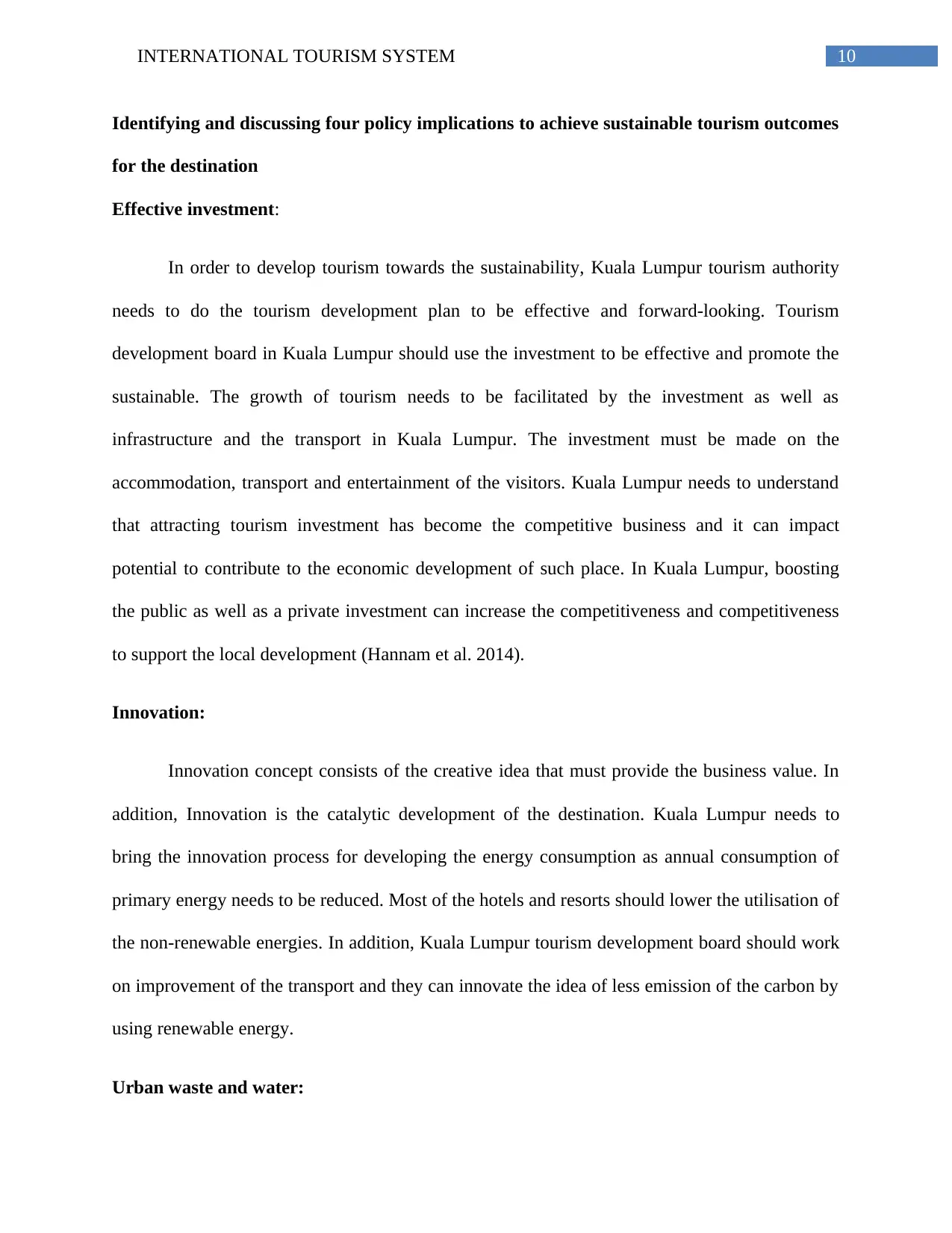
10INTERNATIONAL TOURISM SYSTEM
Identifying and discussing four policy implications to achieve sustainable tourism outcomes
for the destination
Effective investment:
In order to develop tourism towards the sustainability, Kuala Lumpur tourism authority
needs to do the tourism development plan to be effective and forward-looking. Tourism
development board in Kuala Lumpur should use the investment to be effective and promote the
sustainable. The growth of tourism needs to be facilitated by the investment as well as
infrastructure and the transport in Kuala Lumpur. The investment must be made on the
accommodation, transport and entertainment of the visitors. Kuala Lumpur needs to understand
that attracting tourism investment has become the competitive business and it can impact
potential to contribute to the economic development of such place. In Kuala Lumpur, boosting
the public as well as a private investment can increase the competitiveness and competitiveness
to support the local development (Hannam et al. 2014).
Innovation:
Innovation concept consists of the creative idea that must provide the business value. In
addition, Innovation is the catalytic development of the destination. Kuala Lumpur needs to
bring the innovation process for developing the energy consumption as annual consumption of
primary energy needs to be reduced. Most of the hotels and resorts should lower the utilisation of
the non-renewable energies. In addition, Kuala Lumpur tourism development board should work
on improvement of the transport and they can innovate the idea of less emission of the carbon by
using renewable energy.
Urban waste and water:
Identifying and discussing four policy implications to achieve sustainable tourism outcomes
for the destination
Effective investment:
In order to develop tourism towards the sustainability, Kuala Lumpur tourism authority
needs to do the tourism development plan to be effective and forward-looking. Tourism
development board in Kuala Lumpur should use the investment to be effective and promote the
sustainable. The growth of tourism needs to be facilitated by the investment as well as
infrastructure and the transport in Kuala Lumpur. The investment must be made on the
accommodation, transport and entertainment of the visitors. Kuala Lumpur needs to understand
that attracting tourism investment has become the competitive business and it can impact
potential to contribute to the economic development of such place. In Kuala Lumpur, boosting
the public as well as a private investment can increase the competitiveness and competitiveness
to support the local development (Hannam et al. 2014).
Innovation:
Innovation concept consists of the creative idea that must provide the business value. In
addition, Innovation is the catalytic development of the destination. Kuala Lumpur needs to
bring the innovation process for developing the energy consumption as annual consumption of
primary energy needs to be reduced. Most of the hotels and resorts should lower the utilisation of
the non-renewable energies. In addition, Kuala Lumpur tourism development board should work
on improvement of the transport and they can innovate the idea of less emission of the carbon by
using renewable energy.
Urban waste and water:
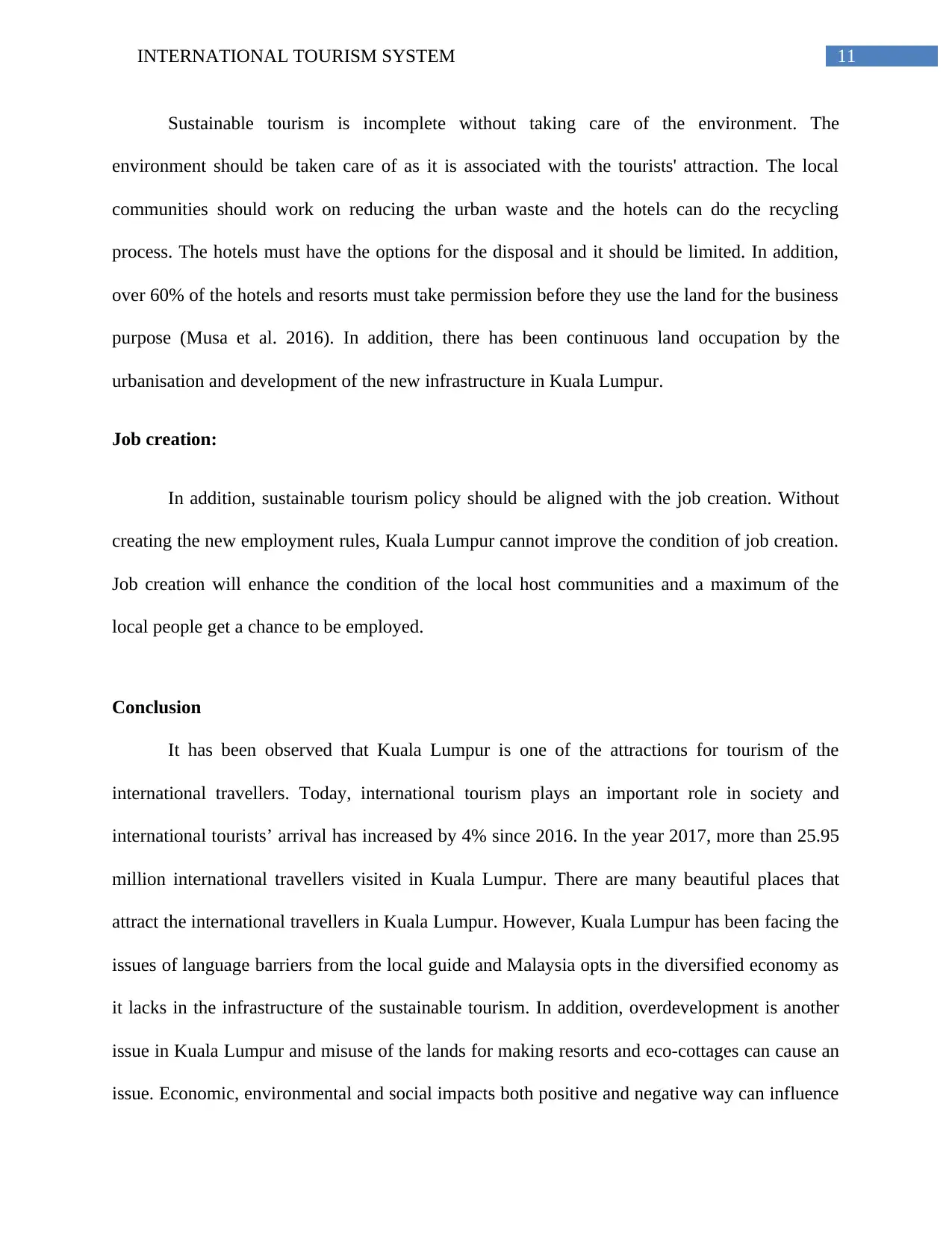
11INTERNATIONAL TOURISM SYSTEM
Sustainable tourism is incomplete without taking care of the environment. The
environment should be taken care of as it is associated with the tourists' attraction. The local
communities should work on reducing the urban waste and the hotels can do the recycling
process. The hotels must have the options for the disposal and it should be limited. In addition,
over 60% of the hotels and resorts must take permission before they use the land for the business
purpose (Musa et al. 2016). In addition, there has been continuous land occupation by the
urbanisation and development of the new infrastructure in Kuala Lumpur.
Job creation:
In addition, sustainable tourism policy should be aligned with the job creation. Without
creating the new employment rules, Kuala Lumpur cannot improve the condition of job creation.
Job creation will enhance the condition of the local host communities and a maximum of the
local people get a chance to be employed.
Conclusion
It has been observed that Kuala Lumpur is one of the attractions for tourism of the
international travellers. Today, international tourism plays an important role in society and
international tourists’ arrival has increased by 4% since 2016. In the year 2017, more than 25.95
million international travellers visited in Kuala Lumpur. There are many beautiful places that
attract the international travellers in Kuala Lumpur. However, Kuala Lumpur has been facing the
issues of language barriers from the local guide and Malaysia opts in the diversified economy as
it lacks in the infrastructure of the sustainable tourism. In addition, overdevelopment is another
issue in Kuala Lumpur and misuse of the lands for making resorts and eco-cottages can cause an
issue. Economic, environmental and social impacts both positive and negative way can influence
Sustainable tourism is incomplete without taking care of the environment. The
environment should be taken care of as it is associated with the tourists' attraction. The local
communities should work on reducing the urban waste and the hotels can do the recycling
process. The hotels must have the options for the disposal and it should be limited. In addition,
over 60% of the hotels and resorts must take permission before they use the land for the business
purpose (Musa et al. 2016). In addition, there has been continuous land occupation by the
urbanisation and development of the new infrastructure in Kuala Lumpur.
Job creation:
In addition, sustainable tourism policy should be aligned with the job creation. Without
creating the new employment rules, Kuala Lumpur cannot improve the condition of job creation.
Job creation will enhance the condition of the local host communities and a maximum of the
local people get a chance to be employed.
Conclusion
It has been observed that Kuala Lumpur is one of the attractions for tourism of the
international travellers. Today, international tourism plays an important role in society and
international tourists’ arrival has increased by 4% since 2016. In the year 2017, more than 25.95
million international travellers visited in Kuala Lumpur. There are many beautiful places that
attract the international travellers in Kuala Lumpur. However, Kuala Lumpur has been facing the
issues of language barriers from the local guide and Malaysia opts in the diversified economy as
it lacks in the infrastructure of the sustainable tourism. In addition, overdevelopment is another
issue in Kuala Lumpur and misuse of the lands for making resorts and eco-cottages can cause an
issue. Economic, environmental and social impacts both positive and negative way can influence
⊘ This is a preview!⊘
Do you want full access?
Subscribe today to unlock all pages.

Trusted by 1+ million students worldwide
1 out of 16
Related Documents
Your All-in-One AI-Powered Toolkit for Academic Success.
+13062052269
info@desklib.com
Available 24*7 on WhatsApp / Email
![[object Object]](/_next/static/media/star-bottom.7253800d.svg)
Unlock your academic potential
Copyright © 2020–2025 A2Z Services. All Rights Reserved. Developed and managed by ZUCOL.




